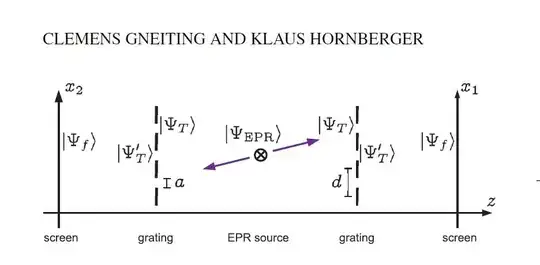Edited question to face complaints about ambiguity
Following experimental setup.
Bob uses a nonlinear crystal to create two entangled photons A and B.
Consider a standard pair of EPR-entangled particles (correlated position and momentum values) with a joint wavefunction.
He sets up two double slits close to each other. I will refer to them as right and left double slit. (note that there are TWO double slits. Hence 4 slits total)
Photon A goes through the right double slit undisturbed.
Photon B runs through a long, coiled up, fiber optic cable, roughly 10 times the length of the distance to the moon, hence B will take about 10 seconds to come out at the other end. Bob decides to either disturb the photon by measuring some of it's quantum states or not to disturb it, depending on a coin flip he does at 8 seconds into the experiment.
(we ignore that we would require repeaters for lengths higher than 200km to keep it simple)
Instead of Bob creating just 1 entangled photon pair, he creates a million entangled pairs and goes on to check two cases.
case 1) Timeline: Bob creates 1 million photon pairs. Bob checks the pattern on the screen behind the right slit, the 1 million non-delayed photons (An) created. At about 8 seconds, Bob flips a coin. The coin turns out to be HEADS.
Bob allows photon B to go through the left double slit undisturbed after coming out of the fiber optics cable at around 10 seconds.
-
case 2) Timeline: Bob creates 1 million entangled photon pairs. Bob checks the pattern on the screen behind the right slit, the 1 million non-delayed photons (An) created. At about 8 seconds, Bob flips a coin which turns out to be TAILS.
Bob disturbs the photon B by doing some measurement(setting up a unit-efficiency quantum detector directly behind one of the two slits of the left double-slit) such that it would allow the "which path" to be known when going through the double slit.
The question is. Will the pattern the 1 million entangled photons (An) created on the right screen in case 1), be discernible from the pattern in case 2), in the sense of being able to state with high probability which of the 2 cases applies, by analyzing the distribution of the photons (An), which hit the screen after passing through the right slit?
edit: Or otherwise stated. Would we be able to make a statement, at 0-1 seconds into the experiment, by observing the pattern behind the right slit the non-delayed photons have caused, in the form of "the experiment has a higher/lower probability to take the course of case 1 rather than case 2", beforehand?
If the answer to that question is yes, then doesn't Bob already know (with high probability) at the beginning of his experiment (0-1 seconds), what the result of his coin flip at 8 seconds will turn out to be?
Before answering the question, i would like you to describe the pattern we would see (behind the right slit created by the non-delayed photons) in case 1) vs case 2), if we were to actually perform this experiment.
This is not the same as the delayed choice quantum eraser. We are using a million photon pairs, which is a different scenario, as the objection of many was that we cannot tell the interference/no-interference pattern by just observing a single photon. It's also different in the sense that we are just using two simple double slits, allowing us to not get lost in the details of different measuring devices.
edit: So i found a similar experiment proposed by John Hatter labeled "Superluminal information transmission using a double-double-slit apparatus"
In this experiment, the particles are entangled as follows: quote "Consider a standard pair of EPR-entangled particles (correlated position and momentum values) with a joint wavefunction"
He then uses a unit-efficiency quantum detector immediately behind A's left slit(B’s left slit in my case) to extract the which path information and therefore destroy the interference pattern.
quoting part of the document
Now, of course, left to themselves, both detection screens should exhibit the classic interference effect. Now however, take one of the double-slits (lets take A) and put a small, unit-efficiency quantum detector immediately behind A’s left slit. Let us be clear that the detector is directly behind A’s left slit and therefore well in front of the screen. In fact, let the detector be so close to the slit that if we ever get a hit, we can say with a high degree of certainty which path the particle took. This should (of course) destroy the interference pattern on the detection screen behind double-slit A since we now have whichpath information for A. But consider our results derived above ... since the scattering potentials of A & B double-slits are conjugates, when the particles encounter their respective double-slits, their paths will be correlated . In other words if one particle uses the left-slit path of A, the other must use the left-slit path of B...
(in my experimental setup B is the equivalent of A in the setup John Hatter proposed)
Conclusion: It does not take much work to see how this could be used to perform superluminal signalling. By allowing EPR-entangled particles to propagate in an environment similar to that described above, and by sequentially destroying and preserving the interference effect, information could be transmitted. Since the interference effect is destroyed as soon as we gain knowledge of which-path
I hope that satisfies some as in defining the experimental setup more precisely.


